
Installation view of “The Future is Behind Us” by Rachel Wolfson Smith, on view at Women and Their Work. Photo: Hector Tednoir Martinez
“Woman is the mothering element in the world and her vote will go toward helping forward the time when life’s Bread, which is home, shelter and security, and the Roses of life, music education, nature and books, shall be the heritage of every child that is born in the country, in the government of which she has a voice.” – Helen Todd (1910)
The above excerpt is from a speech Helen Todd delivered in 1910 advocating for women’s right to vote in the U.S., inspiring the phrase “bread for all, and roses, too,” which has since been used globally in poetry, literature, and music. The metaphor expresses that everyone is deserving of basic sustenance, Bread, and the things that enlighten the human experience, Roses. Todd designates nature as a Rose of life, food for the soul. In The Future is Behind Us, on view at Women and Their Work until September 29, Rachel Wolfson Smith considers how the beauty of the landscape feeds us spiritually, particularly during times of oppression or conflict, by examining human relationships with nature in the past, present, and imagined future.

Installation view of “The Future is Behind Us” by Rachel Wolfson Smith, on view at Women and Their Work. Photo: Hector Tednoir Martinez
Esteemed for her immersive graphite drawings, Wolfson Smith introduces two new mediums to her practice in this show: cyanotype and clay. Exhibited together, the cyanotypes, graphite drawings, and ceramic works represent different eras: past, present, and future, respectively. As I entered the gallery, the bright cobalt cyanotypes on the left wall immediately caught my eye, and my feet blindly followed. The initiating cyanotype, unframed and offset from the seven framed works further down the wall, wears an outline of ferns and other foliage that encircle the text: “the future is behind us.”
The phrase, which titles the exhibition, is seemingly an oxymoron. According to Wolfson Smith, through her sci-fi-movie-watching hobby she noticed characters inevitably seek connection with the landscape during tumultuous times, which begged the question: what is the role of the landscape in the future? Most of these sci-fi movies were set approximately 150 years into the future, and with the understanding that history is bound to repeat itself, Wolfson Smith sought an answer by looking to the past by the same 150 years. This landed her in the Victorian Era.
The cyanotype series exudes serenity. The delicate flowers, vines, and leaves float against the blue photosensitive paper as if suspended in water. The pieces vary in saturation due to Wolfson Smith’s technique of removing some elements and moving others around the page after timed exposures. As I walk the wall’s length, examining how the photographic process abstracts the foliage, I can’t help but recall Anna Atkins’ cyanotypes. Atkins’ father, John George Children, worked at the British Museum and was the first president of the Royal Entomological Society of London, which allowed Atkins access to scientific circles and work fields that most women were not granted at the time. Working closely with her father, Atkins participated in fieldwork botanical studies illustrating specimens onsite. Before the invention of photography, scientists relied on detailed illustrations and descriptions to record objects. Atkins began using the cyanotype process to document specimens, instead of illustrating them, in order to obtain a more objective representation.
Cyanotype is one of the first photographic processes, and does not require a camera or a darkroom to replicate an object’s likeness. Instead, the process is essentially documenting light, which is rendered in the shape of the specimen left on the page. Atkins published her cyanotypes in Photographs of British Algae: Cyanotype Impressions in 1843, the first-ever photographic book. Now, Atkins’ cyanotypes are appreciated for their formal qualities in how they replicate organic matter using a new photographic technique; at the time, however, they were a practical innovation for documentation in the scientific community, an industry that seldom included women and much less heralded them for their contributions. During this era, there was also a social shift that spurred the perpetuation of organic motifs within commodity culture and in the domestic sphere.
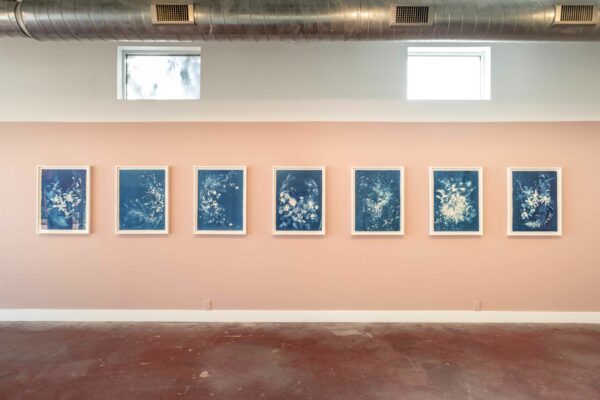
Installation view of “The Future is Behind Us” by Rachel Wolfson Smith, on view at Women and Their Work. Photo: Hector Tednoir Martinez
In the 17th century, botanical interests were considered an acceptable hobby for women, and many began hosting outdoor excursions to find and collect plants to bring inside the home. This led to the commodification of natural forms in clothing, home decor, and jewelry. At a time when social codes limited women’s freedoms and participation outside of the domestic sphere, the natural world offered opportunities for creativity and exploration. By using a photographic process that precedes the camera, Wolfson Smith offers a glimpse into past traditions born out of the human impulse to retreat into nature as a mode for grappling with adversity. In the same way that women used nature to process personal and cultural pressures in eras past, Wolfson Smith uses her drawing practice as a “process of processing’ her own internal needs and struggles.
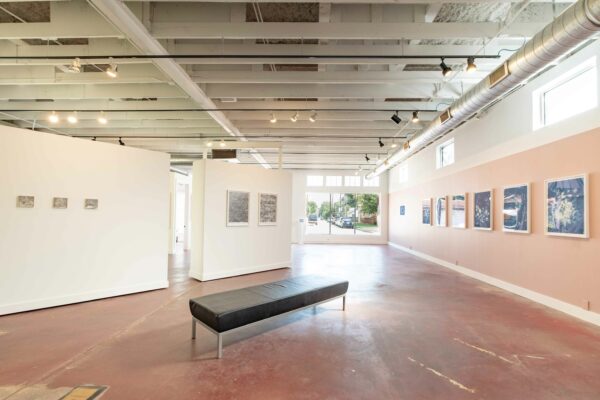
Installation view of “The Future is Behind Us” by Rachel Wolfson Smith, on view at Women and Their Work. Photo: Hector Tednoir Martinez
As I turn my back to the end of the cyanotype sequence, I encounter two walls diagonally intersecting the center of the gallery bearing graphite drawings on either side. Each work is varied in scale and abundant in detail. Wolfson Smith likens her drawing practice to screen printing, creating shapes according to light and shadow by carving out forms with an eraser as much as she produces them with graphite. The mark-making is scratchy, eliciting the sensation of walking through an overgrowth. Overlapping vines amass into dense walls, blades of grass mingle with twigs, flowers peek through dark shadows of vegetation, and…severed hands spiral into one another.
In Caregivers (the largest drawing included in the show, sprawling out at 40 x 90 inches), limbs synchronize with vines, leaves, and daisies, one nearly indistinguishable from the next. Scattered throughout the composition, hands emerge from the shadows to bridge vines together or sway among them. Fingers stretch out like flower petals. Some hands are limp and elongated, as if boneless, and others part stems with coordination. Their gestures convey different acts and intentions — some work to comb through the entangled foliage, as if to assist me as a viewer in peering into the depths, while others contribute to its facade. Their varied expressions bring to mind how hands can communicate nonverabally, and are therefore capable of symbolizing many facets of the human experience, from violent acts to tender caresses. According to Wolfson Smith, the hands surfacing in her drawings indicated a need for care in her life, and elicited a reflection on the various gestures that care can take form as.
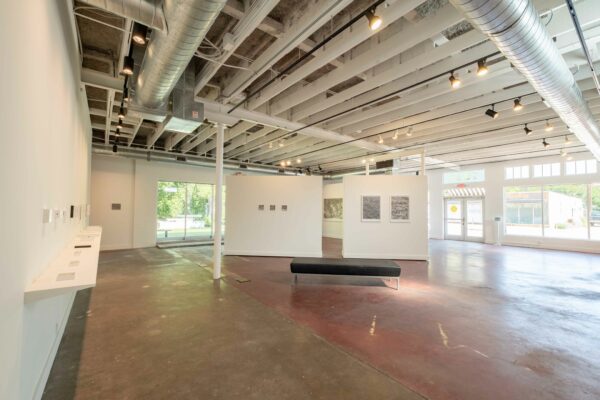
Installation view of “The Future is Behind Us” by Rachel Wolfson Smith, on view at Women and Their Work. Photo: Hector Tednoir Martinez
In the same way that caring gestures leave marks on the soul, physical gestures leave marks on the land. As I work to untangle the intertwining landscape visually, I think about the marvel of encountering a very old tree, in awe of how many hands have ever caressed its trunk in passing, or that have plucked a flower from the ground nearby, silently altering the scene. Nature complies with our actions and then continues its growth around the indexes we leave, casting present moments into the past with each unfurling leaf. The drawings mimic this relationship between human activities and the landscape; graphite is traceable, so even erased marks leave behind a faint indication of past gestures, building layer upon layer. Further, Wolfson Smith leaves mementos of her process by incorporating written text into her rendered landscapes from auditory cues that she’s consuming while drawing.
In Under Nights Coverb— a small drawing of swooping blades of grass — dark handwritten text stands out against the white foreground, reading: “has a consequence in the present.” The fragmented sentence reminds me that both the landscape and the graphite drawings span past and present by collapsing numerous moments into one scene. The hands in the landscape represent the artist using nature as a subject to reflect on mind-body connections in working through personal needs, and the innate human impulse to seek meditation in nature.
Throughout history, there have been notable trends when humans have retreated into nature in response to industrial and technological advancements. Turning to the back wall, I see a row of Apple boxes for various devices neatly aligned above a long white shelf. Their sleek design set against the white wall is a compelling replica of an Apple store. For a split second, I think it must be the installation of another artist, but as I approach the shelf and peer into the flat upward-facing boxes resting upon it, I’m greeted by Wolfson Smith’s familiar organic forms. Ivies and intricate roses fill the boxes instead of Macbooks and iPads, and their deep reliefs cast shadows between and below, like lavish cakes packaged and ready to go. Though detailed and complex, the ceramic foliage is not as fluid as those in the cyanotypes, nor as gesturally expressive as those Wolfson Smith renders in graphite. They’re too orderly for the natural world. Wolfson Smith’s fingerprints can be detected on a small rose petal, hinting at the works’ true craftsmanship.
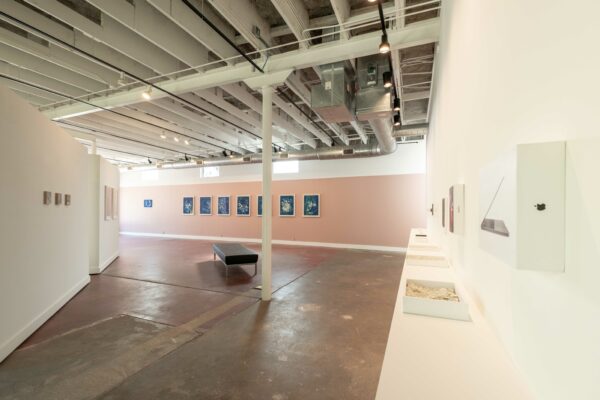
Installation view of “The Future is Behind Us” by Rachel Wolfson Smith, on view at Women and Their Work. Photo: Hector Tednoir Martinez
This synthetic execution of natural forms for the imagined future is not historically unfounded. In the 1700s, trends in English landscape architecture shifted from perfectly manicured gardens to rogue landscapes, engineered to appear as though they were weathered by the elements rather than man’s hand. Wolfson Smith’s cheeky prediction anticipates an imagined society that opts for nature’s beauty to be left on one’s doorstep rather than to have one seek it out of doors. Or, is there no landscape left to enjoy? There is no impending dystopian doom in her work, though — instead, there’s a sense of playful speculation and artistic experimentation. Nodding to the instant gratification that’s facilitated by our supersaturated commodity culture, Wolfson Smith insists on the importance of finding solace in nature and the profound spiritual fulfillment it provides.
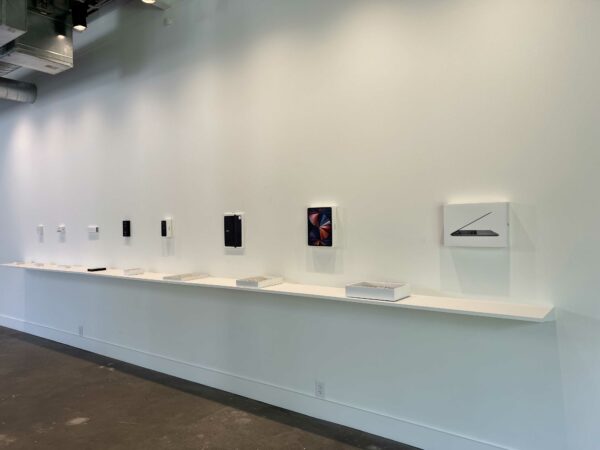
Installation view of “The Future is Behind Us” by Rachel Wolfson Smith, on view at Women and Their Work. Photo: Hector Tednoir Martinez
While the human race is only as sustainable as the Earth is, The Future is Behind Us is not calling on viewers to take action in reversing the effects that our activities have had on the climate in order to preserve its livability — the Bread, to recall Helen Todd’s metaphor. Rather, Wolfson Smith is encouraging us to look beyond the ecological functions of nature and instead appreciate the effects that its beauty has on us mentally and spiritually — the Rose of life — because we are intrinsically linked to it.
The multidisciplinary show uses cyanotypes, graphite drawings, and clay to demonstrate the human tendency to look to nature when seeking freedom from oppressive environments, answers to personal needs or conflicts, and in response to technological innovations in the past, present, and imagined future. It was not for another ten years after Todd delivered her speech, rallying for women’s right to vote, that the 19th amendment was passed. The Future is Behind Us prompts me to reflect on how history is repeating itself today, just shy of 50 years after Roe v. Wade was passed, and less than three months after it was overturned. “Expect to see a lot of flower motifs,” Wolfson Smith forecasts.
The Future is Behind Us is on view at Women & Their Work in Austin through Spetember 29, 2022.


